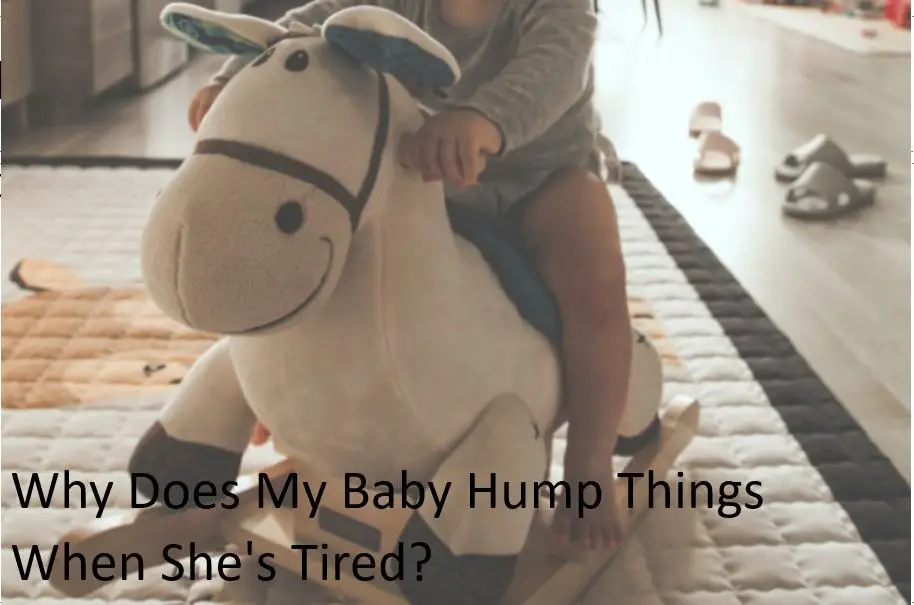Why Does My Baby Hump Things When She’s Tired? (Here’s What You Need To Know About Pelvic Thrusting)

So, why does my baby hump things when tired?
I do realise how absurd it sounds in relation to babies.
…Until you witness such behaviour in your own baby!
Whilst humping things by some babies may be disturbing, if not embarrassing, to their parents. In fact, it is normal behaviour.
And most certainly, it is not something they learned, but it’s a totally subconscious and innocent action. And soon enough – they will outgrow it.
So, fear not and simply accept it as yet another little quirk we have to live with.
Ok, so without further ado, let me put your mind at ease and allow me to explain why your baby feels the need to hump things when she’s tired.
Why Does My Baby Hump Things When She’s Tired?
The simple answer is your baby most likely finds a repetitive humping motion soothing. And it helps them to relax and settle for sleep. This behavior is normal, unless the movement hurts your baby or prevents them from sleeping. In such a situation, you should contact your child’s doctor.
Humping (aka rocking) Themselves To Sleep
By “ humping” things, your baby is doing nothing different from following a pattern of repetitive and rhythmic back-and-forth movement.
Which is yet another self-soothing mechanism.
(Among many less unorthodox ones, such as grabbing their ears for comfort, sucking their thumbs, or covering their faces with blankets).
All these actions allow them to relax and ease into a restful mode.
Rocking (or what may look like “humping”) movement most likely occurs because babies associate rhythmic, repetitive action with sleeping and relaxation!
They developed this association during the good old days of pregnancy. Then, babies were rocked constantly by their mothers as they moved.
So, when they feel tired, babies will rock themselves back and forth until they fall asleep. The movement will usually stop once they are fast asleep.
And if you think that’s weird, what do parents of babies who bang their heads against a surface have to say?!
As a matter of fact, head banging is also in the same “category” of repetitive movement, but perhaps of a more fragile part of their body.
Both these soothing mechanisms are common in healthy babies between 6-9 months. These episodes typically occur before their naps or bedtime.
And the good news is – these habits will most likely go away by the age of 3 years.
So generally, it is nothing to be worried about unless, of course, this behaviour results in injury or interferes with sleep.
In such cases, you should ask for help from your healthcare provider for guidance and to rule out a sensory condition, such as rhythmic movement disorder, or a medical condition like epilepsy.
So, what is A Sleep-Related Rhythmic Movement Disorder?
So, to reiterate. Rocking themselves to sleep is considered a normal stage of early development. Unless the movement causes harm to your baby and disturbs their sleep, or when your child didn’t outgrow, and the rocking to sleep habit continues into adulthood.
In such cases, we are talking about rhythmic movement disorder.
What is also worth noting is that it is not only the “humping” movement that constituent the rhythmic movement disorder. Other types of repeated movement often include:
- Head banging against any surface, such as a wall, crib, mattress, or pillow.
- Head rolling from side to side when lying on their back.
In severe cases, medication will be prescribed to treat this neurological condition.
Can Nocturnal Rhythmic Movements Harm a Child?
Can Humping Be A Sign Of Autism Spectrum Disorder?
The short answer is no, not necessarily.
However, it is true that children with autism spectrum disorder frequently exhibit repetitive movement, like body rocking, arm flapping or object spinning.
Furthermore, there are quite distinctive (and easy to spot) physical differences between them.
Specifically, babies with autism spectrum disorder will:
- Rock their body back and forth or bang their head during the day, not when drowsy before nap or bedtime.
- While making no eye contact, they will rock or bang their heads in a trans-like state.
- In contrast to self-soothing and settling to sleep, the movement will be very forceful, and they may suffer injury.
If you are concerned that your baby may have any form of spectrum disorder, you should consult the doctor and clear your doubts.
So, What Should I Do When My Baby Humps Things?
You should first refrain from interfering and discouraging your baby from making these funny movements if you feel tempted to stop them from doing so.
(Remember? It is just a phase that will pass soon enough!)
If your baby is trying to comfort themselves to sleep, you should support this attempt.
Furthermore, you could quickly hand them the lovey to speed the process of falling asleep – if not just shift their attention to something else.
And, of course, if there is any concern that your baby may hurt herself while humping or rolling – just make sure the place is safe. So cover all sharp corners and edges with appropriate corner guards and edge bumpers to keep your baby out of harm’s way.
Related Post ==⇒ How To Introduce A Lovey To Your Baby?
Final Few Lines
I think parenthood never ceases to amaze parents.
When we thought we’d seen it all…
There it is.
Banging things to soothe themselves for sleep.
Another unexpected behaviour from our little ones making us feel puzzled, concerned, or even mortified.
No matter what object is being humped: a pillow, a bed, a stuffed toy, a blanket, or even your leg.
We are often caught off-guard seeing such behaviour in our babies, not knowing what to make out of that.
Thankfully, in most cases, it is a completely normal, harmless behavior that is part of their growing journey…
